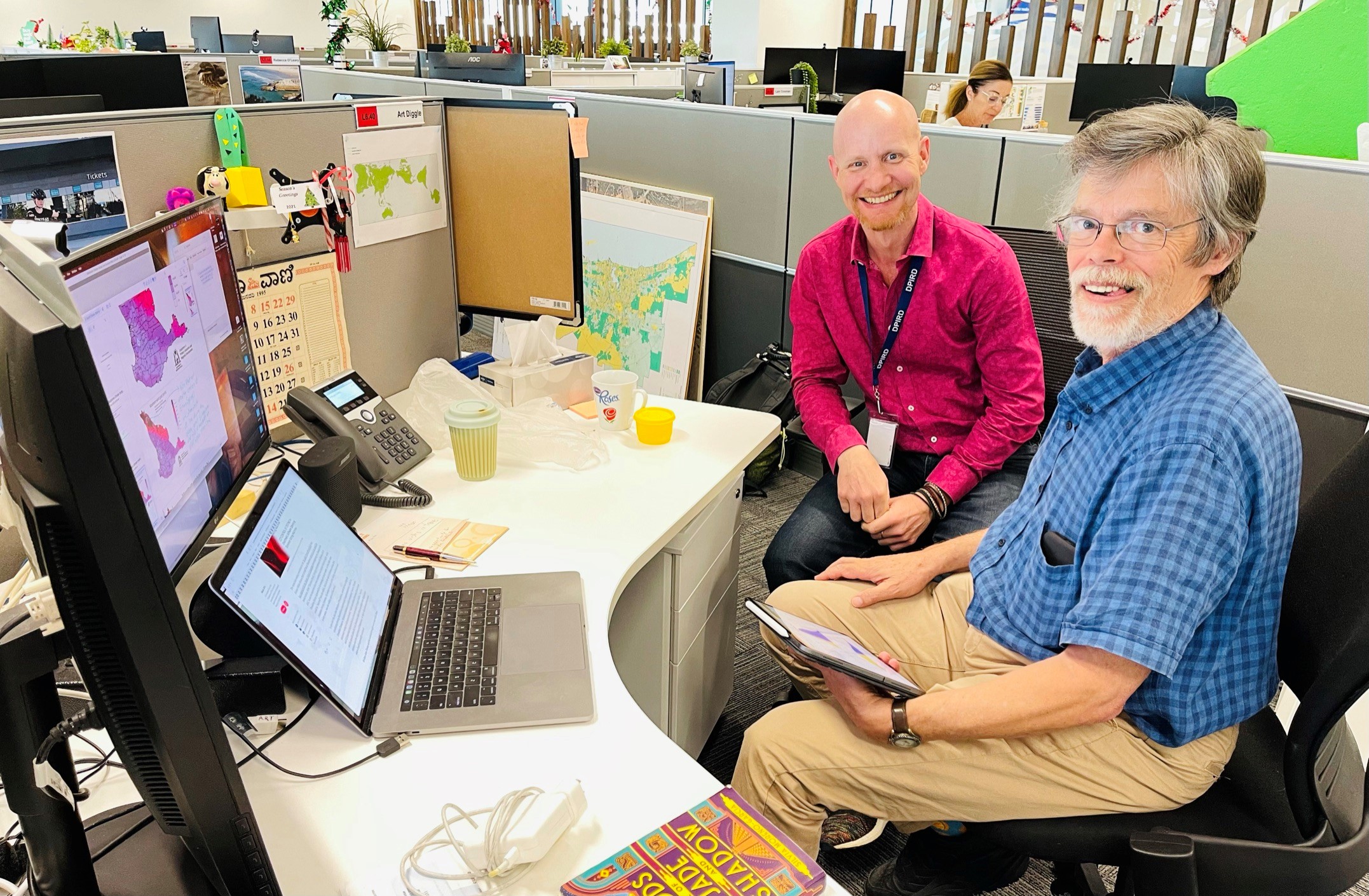WA Farm Data Sharing
Unlocking the value in data
If you’ve been seeking to make more streamlined, data driven decisions to improve your investment strategies, read more here about the joint venture making this possible for the near future.
Step into the future of on-farm decision making
DPIRD team members: Dr Art Diggle (front) and Dr Adam Sparks (rear)
The WA Farm Data Sharing (WAFDS) joint initiative by DPIRD in partnership with GGA , Curtin University and the Food Agility CRC is promising to change the way growers make complex investment decisions by unlocking the value in the data collected on farm.
No longer will growers have to manually assess future investment strategies. Welcome to the future of data driven decision making technology with the WAFDS modelling initiative.
So how does it work?
DPIRD Farming Systems Innovation Principle Research Scientist, Dr Art Diggle says the whole farm bio-economic model will help growers make better decisions that can be scaled across their business.
“Data driven decision making is using a grower’s data to make the best tailor-made choices for them and their business.”
“Each paddock and each business and everyone’s circumstances are different and one size definitely doesn’t fit all,” Dr Diggle says.
“The WAFDS model is a whole farm bio-economic model that tracks income and expenses for all paddocks for several years including factors that affect productivity, such as acidification of the soil.”
“The model tracks cash flow for many possible runs of future seasons and prices and produces estimates of the best, worst and most likely returns and peak debt for each of the management strategies being considered,” he says.
Whilst the project shows promise and WA’s agriculture industry is abundant with data, Dr Diggle’s colleague and project lead, DPIRD Farming Systems Innovation Senior Research Scientist Dr Adam Sparks says getting growers to adopt a digital approach to data collection has proven challenging.
“If you can’t measure it, you can’t manage it,” Dr Sparks says
“Digital record keeping not only allows for detailed analysis to happen but also the integration of other sources of data to use in these analyses and derive more benefit from them,” he says.
In the first example of demonstrating data transfer for whole farm benefit from specific decision making, the project’s blue sky goal is to integrate farm business records with weather and soil data to provide a liming investment strategy to growers.
“This goal will be made possible by the adoption of digital data keeping technology,” Dr Sparks says.
Which Dr Diggle has hope for.
“All growers capture data in some way,” he says
“Traditionally there are some very good and very effective paper and computer- based systems, so there is a huge treasure trove of data.”
“As systems get more automatic and more digital, the cost of collecting and using data falls, so growers are steadily getting better insights and more value.”
This doesn’t mean this type of data collection comes without obstacles.
Dr Diggle says it’s not uncommon for growers to show apprehension when handing over valuable business data to external research and modelling bodies.
“The project team and the participating growers and companies will all be working to build trust and demonstrate value from information exchange, and the methods that are developed in the project will make it easier to get high returns in future endeavours,” he says.
The project is collaborating closely with grower groups as part of an early adopter community. Michelle Condy, GGA Program Broker says, the grower groups input into the early consultations and planning meetings has been essential to help guide the trajectory of the project, and ensure the model and data transfer infrastructure are fit for purpose and provide value to the grower.
Early Adopter Community
Esperance Zone Innovation, whose members have committed to being the first three growers to share data and receive a liming model, have been instrumental in helping the project develop data sharing agreements.
Dr Diggle explains of the data agreements.
“The project will reach a detailed, documented agreement with each participant describing exactly what data the project will use and exactly what the data will be used for and over what time period.”
“No data will be accessed or used outside of this agreement,” Dr Diggle says.
Concerns aside, the project team says this type of data-driven decision-making technology could be the way forward in combating the challenges agriculture faces.
“In the future growers will be able to quickly assess different strategies for their whole farm with the touch of a button,” Dr Sparks says.
“Seamless data transfers and cloud-computing will allow for instant responses from models that are tailored for a farm’s unique situation and enable more informed decisions to be made.”
“This approach can be applied to pest and disease management, planning for managing drought and other challenges that growers face,” Dr Sparks says.
Dr Diggle agrees, and can see significant benefits for growers when adopting this type of technology into their farming program.
“As digital connectivity and standards increase there will be a tipping point where things will snowball.”
“We are on the edge of big changes and we need to be prepared so that Australian industry can capitalise on the opportunity,” he says.
Get involved
If your grower group thinks this project could be of interest to your membership, the WAFDS project is still accepting groups and individual growers as part of the early adopter community. Suitable growers will receive a whole of farm liming investment model.
Contact Alison Lacey at GGA .

